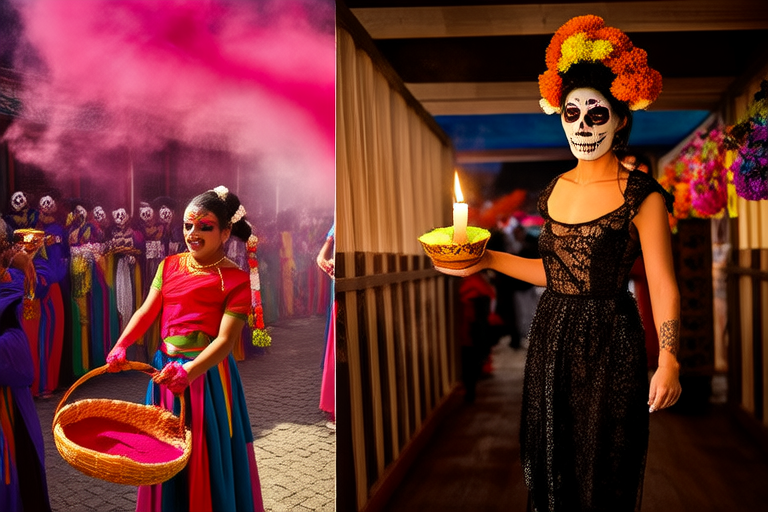Illuminating Cultural Practices: A Journey Through Diversity

Illuminating Cultural Practices: A Journey Through Diversity
Introduction
Cultural diversity refers to the variety of cultural practices, beliefs, and traditions that exist within and among societies. Each culture has its own unique set of customs, languages, arts, and cuisines that reflect its historical development and societal values. Understanding these differences is crucial because it fosters mutual respect, promotes tolerance, and encourages cross-cultural dialogue.
This article embarks on a journey through the rich tapestry of global cultural practices. By exploring ancient traditions, modern celebrations, art and craftsmanship, food and cuisine, and language, we aim to highlight the significance and beauty of cultural diversity. Our exploration will reveal how these practices continue to shape our world today.
Section 1: Ancient Traditions
Ancient cultural practices offer a window into the past, revealing how early societies lived, worshipped, and celebrated. In Asia, for instance, the Chinese Dragon Dance has been performed during Lunar New Year celebrations for centuries. This vibrant ritual involves dancers moving in unison while holding poles attached to a dragon puppet, symbolizing prosperity and good fortune. Similarly, in Africa, the Duk-Duk society of Papua New Guinea uses elaborate masks and costumes to enforce moral codes and maintain community order.
In Europe, the ancient Roman festival of Saturnalia, which honored the god Saturn, was characterized by feasting, gift-giving, and role reversals where slaves were treated as equals. These traditions have left lasting imprints on modern Western holiday customs. Such practices not only provide insights into the lives of our ancestors but also continue to influence contemporary societies, reinforcing communal bonds and shared heritage.
Section 2: Modern Celebrations
Contemporary cultural celebrations bring people together, fostering unity and preserving cultural identity. For example, Diwali, the Festival of Lights in India, marks the victory of light over darkness and good over evil. Families decorate their homes with lamps and candles, exchange gifts, and enjoy festive meals. Another notable celebration is Carnival in Brazil, featuring colorful parades, samba dancing, and elaborate costumes. Both events showcase the vibrancy of their respective cultures while strengthening social ties within the community.
Similarly, the Day of the Dead in Mexico commemorates deceased loved ones through altars adorned with flowers, photos, and favorite foods. Participants believe that this practice helps guide spirits back to the living world. These modern celebrations serve as vital links between past and present, ensuring that cultural legacies endure across generations.
Section 3: Art and Craftsmanship
Traditional art forms and craftsmanship play pivotal roles in expressing cultural identities. Japanese woodblock printing, known as ukiyo-e, exemplifies精湛的木刻印刷技术,展现了日本的文化身份。通过使用木材、油墨和纸张,艺术家们创作出精美绝伦的作品,这些作品不仅具有美学价值,还承载着深厚的历史和文化意义。此外,印度的手工刺绣也是极具代表性的传统艺术形式之一。工匠们运用各种针法和图案,为纺织品增添了独特的美感和象征意义。这些技艺不仅体现了匠人们的精湛技艺,也反映了他们对传统文化的深刻理解与尊重。
在欧洲,哥特式建筑以其尖拱、飞扶壁和彩色玻璃窗而闻名。这些结构不仅展示了建筑师们的创造力和技术水平,还反映了中世纪基督教文化的宗教信仰和社会价值观。哥特式教堂不仅是宗教仪式的地方,也是社区聚会和文化交流的重要场所。此外,北欧国家的传统编织工艺也非常值得一提。工匠们利用羊毛、亚麻等天然材料,创造出既实用又美观的纺织品。这些作品不仅体现了匠人们的高超技艺,也反映了他们对自然环境的敬畏之情。
这些传统的艺术形式和手工艺不仅展示了不同文化的独特之处,还为现代社会提供了宝贵的灵感来源。通过保护和传承这些技艺,我们可以更好地理解和欣赏人类文化的多样性。此外,这些技艺也为现代设计师提供了丰富的创意资源,促进了跨文化交流与合作。总之,传统艺术形式和手工艺是文化多样性的宝贵财富,值得我们共同珍惜和保